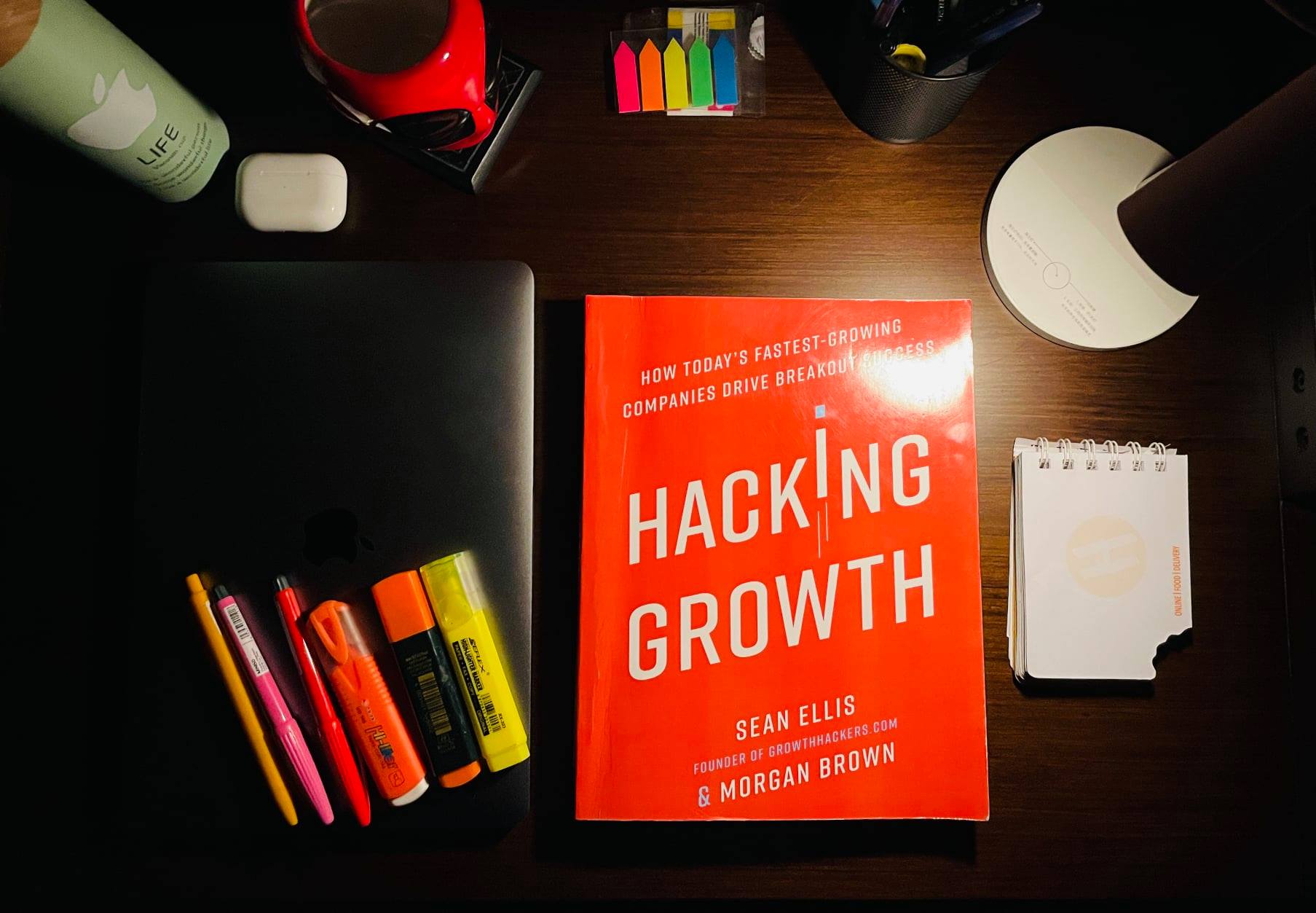Chapter One: Building growth team
Strategic Thoughts:
- The most promising strategy for growth wasn’t to focus exclusively on building the company’s customer base, but also on making the most of the customers they already had.
- The ability to collaborate in networks is more important than raw individual talent to innovativeness.
- Cross-functional teams not only smooth and accelerate collaboration between the product, engineering, data, and marketing groups, they motivate team members to appreciate and learn more about the perspectives of the others and the work they do.
Operational Thoughts:
- The growth hacking process is a continuous cycle comprising four key steps: (1) data analysis and insight gathering; (2) idea generation; (3) experiment prioritization; and (4) running the experiments, and then circles back to the analyze step to review results and decide the next steps.
- Growth teams should bring together staff who have a deep understanding of the strategy and business goals, those with the expertise to conduct data analysis, and those with the engineering chops to implement changes in the design, functionality, or marketing of the product and program experiments to test those changes.
Special Notes:
- A key responsibility for the growth lead is choosing the core focus area and objectives for the team to work on and for what period of time.
- All growth leads require a basic set of skills: fluency in data analysis; expertise or fluency in product management (meaning the process of developing and launching a product); and an understanding of how to design and run experiments.
- There is no one best career background for a growth lead. Some people are now specializing in the role, most of whom have moved into the job from some other area of speciality, such as engineering, product management, data science, or marketing.
Chapter Two: Determining if your product is must have
Strategic Thoughts:
- Love creates growth, not the other way around. And for there to be love, there needs to be that aha moment. Yelp had found its aha moment. This is the moment that the utility of the product really clicks for the users; when the users really get the core value— what the product is for, why they need it, and what benefit they derive from using it. Or in other words, why that product is a “must-have.” This experience is what turns early adopters into power users and evangelists.
- To uncover what makes (or will make) your product a must-have, you need to collect the right data for your business, and build the connective tissue between various sources, such as your email marketing database and your point of sale system, so you can create a complete data picture.
- Once you have discovered a market of avid users and your aha moment—i.e., once product/market fit has been achieved—then you can begin to build systematically on that foundation to create a high-powered, high-tempo growth machine.
Operational Thoughts:
- One of the cardinal rules of growth hacking is that you must not move into the high-tempo growth experimentation push until you know your product is a must-have, why it’s a must-have, and to whom it is a must-have: in other words, what is its core value, to which customers, and why. (The exception to this rule being businesses such as social networks, where the core value is the people on the platform.)
- Growth teams need to adopt rigorous methods for probing into user behaviour in order to discover the core value of their product or service, and we’ll introduce these methods shortly. Additionally, growth teams need to recognize that sometimes establishing what the core value is, or should be, isn’t about the features of the product or service itself, but rather a matter of connecting with the right core market, which, again, as we’ll explore, might be quite different from the originally envisioned one.
Special Notes:
- Just think of Google Glass and Amazon’s Fire Phone—both innovative products…that nobody wanted. Or the infamous Microsoft Zune media player, launched in November 2006, which Microsoft reportedly spent at least $26 million to promote but which never generated more than a tepid response.1 The Zune was not a bad product; many critics considered it quite well designed. But it added no “wow factor” to make it more appealing than Apple’s already ubiquitous iPods.
- Remember that all of this experimentation and analysis should be focused on discovering the aha moment you are offering or can offer, customers. Once the conditions that create that magical experience have been identified, the growth team should turn its attention to getting more customers to experience that moment as fast as possible.
Chapter Three: Identifying your growth levers
Strategic Thoughts:
- Making a product compelling enough to pass the must-have test is the prerequisite for fast and sustainable growth, but in itself, it’s not sufficient. Even truly great products that are loved by a core group of early adopters will almost surely fail without a well-focused effort to vigorously drive growth. So much media coverage of failed products is devoted to ones that professed to be “the next big thing” but that, with hindsight, clearly failed to offer a compelling core product value to a large enough market beyond their early adopters,
- Growth hacking is not about throwing ideas against the wall as fast as you can to see what sticks, it’s about applying rapid experimentation to find and then optimize the most promising areas of opportunity.
- The way to determine your essential metrics is to identify the actions that correlate most directly to users experiencing the core value of your product.
- The North Star should be the metric that most accurately captures the core value you create for your customers.
- The North Star may change over time as the company grows and initial goals are achieved.
- North Star goal helps to keep data analysis tightly focused so you can get your high-impact experiment off the ground as quickly as possible.
- without the right data at your fingertips, your growth team will be flying blind.
- Dashboard: (a) help focus team members’ attention on key trends or metrics; and (b) allow you to share findings with the whole company, which encourages more participation in the growth effort.
- Creating an aha moment and driving more people to it is the starting point for hacking growth. The next step is to determine your growth strategy. You have to understand exactly how you’re going to drive growth—what your growth levers are and whether they are the right ones to achieve desired results—before you move into high-tempo testing of growth ideas.
- In the early phase of growth, you want to craft a strategy for running the experiments that will have the greatest impact on growth in the least amount of time. The more focused efforts are at the start, the more intentional your experiments will be, and the more impact you’ll achieve.
- The first step in determining your growth strategy and figuring out where to focus is to understand which metrics matter most for your product’s growth.
Operational Thoughts:
- While all products will share common drivers of growth, such as new user acquisition, higher activation, and better retention, each product or business has a more specific combination of factors that are uniquely its own.
- To hone your growth equation and narrow your focus, it’s best to choose one, key metric of ultimate success that all growth activity is geared toward. This is hugely helpful in keeping teams focused on the most productive use of their time and avoiding the wasting of resources that generally results from haphazard, scattershot approaches to growth experiments.
Special Notes:
- For Uber, for example, one crucial factor is the number of drivers, because there must be enough of them in any given location to ensure the aha moment of a ride showing up quickly. The number of riders is also crucial, not only for generating revenue, but for assuring that there’s enough demand for drivers so that those who do sign on keep driving.
- For Facebook, while the initial strategy was to focus all effort on getting new users to quickly friend at least seven friends in ten days, it evolved as the company grew and priorities shifted, including building the number of advertisers using the site and the international user base through initiatives like the translation engine and Facebook Lite.
Chapter Four: Identifying your growth tempo
Strategic Thoughts:
- The companies that grow the fastest are the ones that learn the fastest. The more experiments you run, the more you learn.
- No matter what your product or what aspect you are testing, each turn through this cycle should be completed on a consistent interval, preferably in one or two weeks (at GrowthHackers we use a one-week cycle). The cycle is managed by a one-hour weekly growth team meeting to review results and agree on the next week’s set of experiments to implement.
- Growth hacking cycle: Analyze> Ideate> Prioritize> Test
- Ideas are the rocket fuel of growth. And you need a pipeline of them delivering a steady flow. As Linus Pauling said, The best way to have a good idea is to have lots of ideas. This is why unbridled ideation is key to the growth hacking process.
- A poor test is one less opportunity to learn, slowing the team down, and bad data can send the team down a very wrong path. That’s why it’s critical that every experiment be designed to produce statistically valid results.
- One of the great things about growth hacking is that even failed experiments can lead to significant learning over an incredibly short time frame
Operational Thoughts:
- Learning more by learning faster is also the goal—and the great benefit—of the high-tempo growth hacking process.
- Many of the leading growth teams regularly run 20 to 30 experiments a week, and some run many more. Early-stage start-ups might be able to launch only one or two tests per week and then steadily build up to a higher volume, while later-stage start-ups and large, established firms might well be able to start out with a much higher number.
- Before you launch into the cycle, you’ll want to hold an initial team meeting, to explain to everyone on the team how the process will work. Here the growth lead should clarify the role to be played by each team member and how they are expected to work both individually and collaboratively to support the team’s work.
Special Notes:
The methods for generating and prioritizing ideas, which we will introduce later in the chapter, should be explained. The growth lead should then ask the data analyst to share the results of the initial analysis done, and the growth lead should present the key growth levers, the North Star metric, and the area of focus or objectives for the team. The team should then set the goal for the volume and tempo of experiments to launch each week; i.e., how many tests they think they can reasonably manage to design and implement. Generally, the data analysts and engineers will have the expertise to make an initial assessment, and adjustments will almost inevitably be made as the process proceeds.





